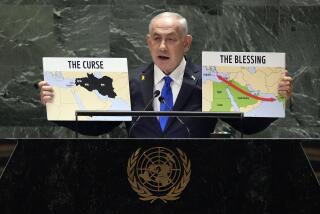U.S. Destroys 1st Nuclear Missiles : Two Pershing Rockets Among 689 to Be Burned Under INF Treaty
- Share via
KARNACK, Tex. — In a few minutes of fire and smoke, the United States destroyed two Pershing missiles Thursday, marking the start of a three-year process that eventually will eliminate 689 American nuclear rockets under a historic arms control treaty with the Soviet Union.
Under the terms of the Intermediate Nuclear Forces treaty signed by President Reagan and Soviet leader Mikhail S. Gorbachev last December, the superpowers will destroy all of their nuclear missiles with ranges between 300 and 3,400 miles. The Soviets, who have more than twice as many of the rockets as the United States, began the destruction process last month.
“This step for peace is something that we all can be very proud of,” Reagan said during a ceremony in the White House Rose Garden. “Today, we begin to put into practice the nuclear missile reductions called for under the INF treaty.”
The pact calls for the Soviet Union to destroy 1,752 missiles. It is the first treaty of the nuclear age to require destruction of existing systems instead of simply limiting their increase.
Tiny Part of Arsenals
But it covers only a tiny part of the superpower arsenals. Washington and Moscow are at an impasse on the far more significant negotiations covering strategic missiles with ocean-spanning ranges. Officials on both sides concede that there is no chance of completing a strategic missile agreement during the four months left of the Reagan Administration.
Vice President George Bush, a delegation of official Soviet observers and a small group of dignitaries from North Atlantic Treaty Organization countries watched the ceremony at the Longhorn Army Ammunition Plant here.
The ground shook for 58 seconds as a Pershing 2 rocket motor, encased in the missile’s 35-foot-long shaft and bolted to a concrete and steel platform, burned itself out. Later, a smaller Pershing 1 was destroyed in the same way in about 30 seconds.
Before the burning, the warheads and guidance systems were removed and placed in storage.
The United States plans to eliminate all of its Pershing missiles, developed at a cost of $2.5 billion, through a similar fire destruction method. Ground-launched cruise missiles, also covered by the treaty, will be sawed into pieces and burned at Davis-Monthan Air Force Base in Arizona.
To destroy their larger stockpile, the Soviets will have to conduct round-the-clock destruction at five separate sites, said the director of the new U.S. On-Site Inspection Agency, Brig. Gen. Roland Lajoie. Monitoring the treaty’s complex elimination procedures will occupy large American and Soviet teams for most of the three-year period.
Although the Administration sought--and obtained--bipartisan support for the INF treaty in Congress, the missile destruction ceremony was tailored to the political needs of Bush’s Republican campaign for the presidency. With less than nine weeks until the presidential election, no important Democrats were on hand for the invitation-only event, which was run by the Army.
‘A New Future Dawned’
“We are witnessing today one of those unique moments in the career of man--a moment when the tides of history turned, that a new future dawned,” said Bush, the only elected official present.
“It’s a moment we will be able to tell our children and grandchildren about. This was the day we began destroying the weapons of destruction.”
Bush collected two small pieces of the destroyed rocket for souvenirs--”one for the President, one for me.”
Bush watched the furious fireball through field glasses from a post 1,300 feet away. The 12 members of the Soviet monitoring team observed the spectacle from a concrete bunker about 800 feet from the firing site.
In warm words that echoed Bush’s remarks, Nikolay Shabalin, deputy director of the Soviet Nuclear Risk Reduction Center, said his inspectors were “eyewitnesses to a significant event. . . . Such activity is unprecedented in the history of mankind.”
Soviet Program Began Earlier
The Soviets began blowing up their intermediate-range missiles Aug. 1 and so far have destroyed 114 SS-12 and SS-20 missiles. The treaty required Moscow to eliminate most of its numerical advantage in medium-range missiles before Washington was obliged to begin its own destruction program.
Before and after the firings, the Russian inspection team was given freedom to examine the engines. They later shook hands with Bush at the site where the first empty motor case was crushed.
Andrei Krutsikh of the Soviet Foreign Ministry good-naturedly tried to talk his way out of the center of a throng of Western journalists who gathered around him near one of the engines.
“Be merciful,” he said in crisp English. “If I go on, you will think all Soviet inspectors are chatterboxes.”
Bush spoke to the NATO diplomats and reporters after the firings.
“A spectacular day. . . . It is truly a great day,” he said.
In addition to burning their banned missiles, the Soviets will take advantage of a provision in the treaty allowing them to destroy as many as 100 missiles by launching them unarmed.
In all, Moscow must destroy about 4,000 other treaty-related items, including stored missiles and launchers, in addition to the 1,752 missiles.
John Balzar reported from Karnack, Tex., and Norman Kempster from Washington.
More to Read
Sign up for Essential California
The most important California stories and recommendations in your inbox every morning.
You may occasionally receive promotional content from the Los Angeles Times.









